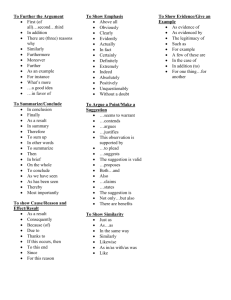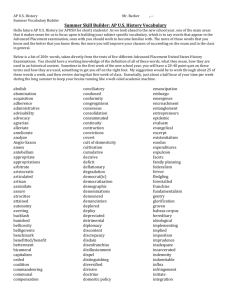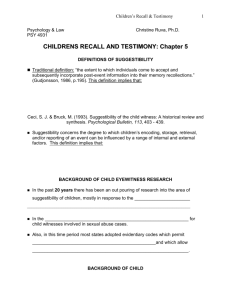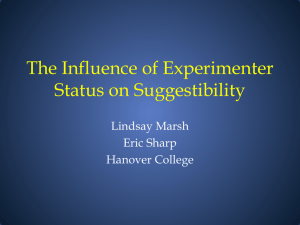Research Report
advertisement
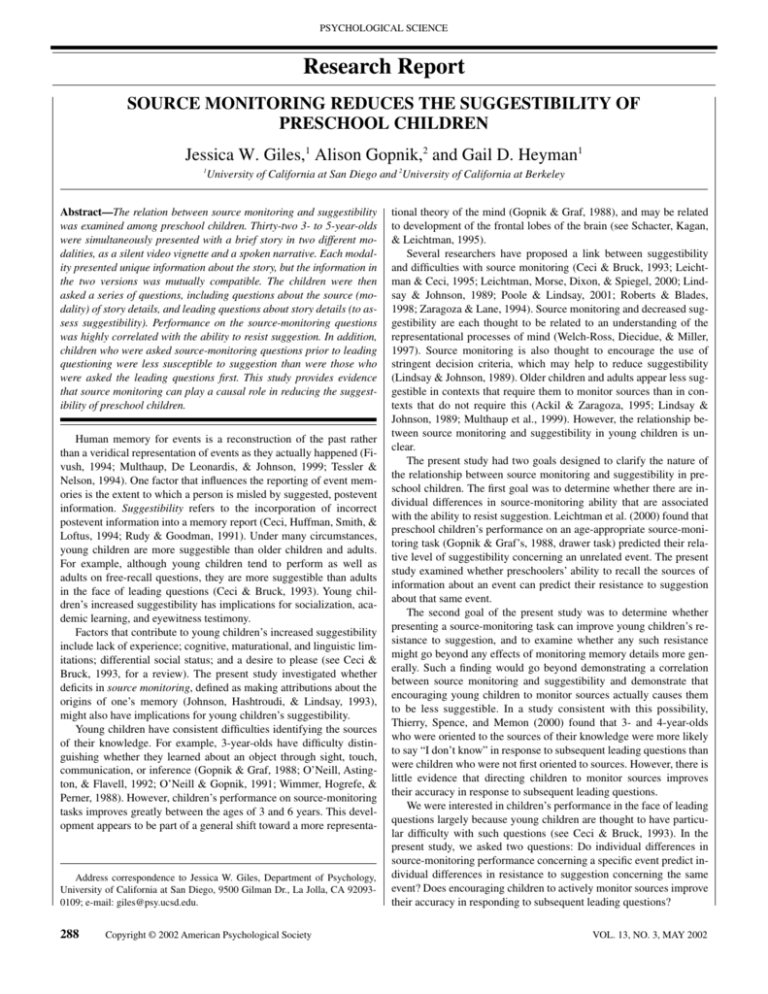
PSYCHOLOGICAL SCIENCE Research Report SOURCE MONITORING REDUCES THE SUGGESTIBILITY OF PRESCHOOL CHILDREN Jessica W. Giles,1 Alison Gopnik,2 and Gail D. Heyman1 1 University of California at San Diego and 2University of California at Berkeley Abstract—The relation between source monitoring and suggestibility was examined among preschool children. Thirty-two 3- to 5-year-olds were simultaneously presented with a brief story in two different modalities, as a silent video vignette and a spoken narrative. Each modality presented unique information about the story, but the information in the two versions was mutually compatible. The children were then asked a series of questions, including questions about the source (modality) of story details, and leading questions about story details (to assess suggestibility). Performance on the source-monitoring questions was highly correlated with the ability to resist suggestion. In addition, children who were asked source-monitoring questions prior to leading questioning were less susceptible to suggestion than were those who were asked the leading questions first. This study provides evidence that source monitoring can play a causal role in reducing the suggestibility of preschool children. Human memory for events is a reconstruction of the past rather than a veridical representation of events as they actually happened (Fivush, 1994; Multhaup, De Leonardis, & Johnson, 1999; Tessler & Nelson, 1994). One factor that influences the reporting of event memories is the extent to which a person is misled by suggested, postevent information. Suggestibility refers to the incorporation of incorrect postevent information into a memory report (Ceci, Huffman, Smith, & Loftus, 1994; Rudy & Goodman, 1991). Under many circumstances, young children are more suggestible than older children and adults. For example, although young children tend to perform as well as adults on free-recall questions, they are more suggestible than adults in the face of leading questions (Ceci & Bruck, 1993). Young children’s increased suggestibility has implications for socialization, academic learning, and eyewitness testimony. Factors that contribute to young children’s increased suggestibility include lack of experience; cognitive, maturational, and linguistic limitations; differential social status; and a desire to please (see Ceci & Bruck, 1993, for a review). The present study investigated whether deficits in source monitoring, defined as making attributions about the origins of one’s memory (Johnson, Hashtroudi, & Lindsay, 1993), might also have implications for young children’s suggestibility. Young children have consistent difficulties identifying the sources of their knowledge. For example, 3-year-olds have difficulty distinguishing whether they learned about an object through sight, touch, communication, or inference (Gopnik & Graf, 1988; O’Neill, Astington, & Flavell, 1992; O’Neill & Gopnik, 1991; Wimmer, Hogrefe, & Perner, 1988). However, children’s performance on source-monitoring tasks improves greatly between the ages of 3 and 6 years. This development appears to be part of a general shift toward a more representa- Address correspondence to Jessica W. Giles, Department of Psychology, University of California at San Diego, 9500 Gilman Dr., La Jolla, CA 920930109; e-mail: giles@psy.ucsd.edu. 288 Copyright © 2002 American Psychological Society tional theory of the mind (Gopnik & Graf, 1988), and may be related to development of the frontal lobes of the brain (see Schacter, Kagan, & Leichtman, 1995). Several researchers have proposed a link between suggestibility and difficulties with source monitoring (Ceci & Bruck, 1993; Leichtman & Ceci, 1995; Leichtman, Morse, Dixon, & Spiegel, 2000; Lindsay & Johnson, 1989; Poole & Lindsay, 2001; Roberts & Blades, 1998; Zaragoza & Lane, 1994). Source monitoring and decreased suggestibility are each thought to be related to an understanding of the representational processes of mind (Welch-Ross, Diecidue, & Miller, 1997). Source monitoring is also thought to encourage the use of stringent decision criteria, which may help to reduce suggestibility (Lindsay & Johnson, 1989). Older children and adults appear less suggestible in contexts that require them to monitor sources than in contexts that do not require this (Ackil & Zaragoza, 1995; Lindsay & Johnson, 1989; Multhaup et al., 1999). However, the relationship between source monitoring and suggestibility in young children is unclear. The present study had two goals designed to clarify the nature of the relationship between source monitoring and suggestibility in preschool children. The first goal was to determine whether there are individual differences in source-monitoring ability that are associated with the ability to resist suggestion. Leichtman et al. (2000) found that preschool children’s performance on an age-appropriate source-monitoring task (Gopnik & Graf’s, 1988, drawer task) predicted their relative level of suggestibility concerning an unrelated event. The present study examined whether preschoolers’ ability to recall the sources of information about an event can predict their resistance to suggestion about that same event. The second goal of the present study was to determine whether presenting a source-monitoring task can improve young children’s resistance to suggestion, and to examine whether any such resistance might go beyond any effects of monitoring memory details more generally. Such a finding would go beyond demonstrating a correlation between source monitoring and suggestibility and demonstrate that encouraging young children to monitor sources actually causes them to be less suggestible. In a study consistent with this possibility, Thierry, Spence, and Memon (2000) found that 3- and 4-year-olds who were oriented to the sources of their knowledge were more likely to say “I don’t know” in response to subsequent leading questions than were children who were not first oriented to sources. However, there is little evidence that directing children to monitor sources improves their accuracy in response to subsequent leading questions. We were interested in children’s performance in the face of leading questions largely because young children are thought to have particular difficulty with such questions (see Ceci & Bruck, 1993). In the present study, we asked two questions: Do individual differences in source-monitoring performance concerning a specific event predict individual differences in resistance to suggestion concerning the same event? Does encouraging children to actively monitor sources improve their accuracy in responding to subsequent leading questions? VOL. 13, NO. 3, MAY 2002 PSYCHOLOGICAL SCIENCE Jessica W. Giles, Alison Gopnik, and Gail D. Heyman METHOD Overview Preschool children were presented with a story about a young boy feeding his dog. The story was presented in two modalities simultaneously: as a silent video and as a spoken narrative read by the experimenter. Following presentation of the story, the children were asked a series of questions. The answer to any given question could come from only one of the two possible sources. The questions were organized into four different tasks, of which each participant received three. Participants were randomly assigned to condition. For all participants, the first two tasks included a suggestion task, designed to measure children’s resistance to suggestion, and one of two monitoring tasks. One of the possible monitoring tasks, sourcemonitoring task A (SMA), measured the children’s ability to identify the source of specific story details. The other monitoring task, the detail-monitoring task, measured the children’s recall of story details. The nature of the monitoring task, and the order in which the first two tasks were presented, was varied in a 2 (task type) 2 (task order) between-subjects factorial design. The task-order manipulation was used to assess whether encouraging children to monitor sources would increase their resistance to subsequent leading questions. The task-type manipulation was included to determine whether any reduced suggestibility effects would be specific to source monitoring, or whether they would also be obtained with a detail-monitoring task that encourages elaborative processing of an event memory (see Pezdek & Roe, 1995, concerning the possibility that elaborative processing of an event memory reduces suggestibility). All participants were given the same third task, source-monitoring task B (SMB), which was similar in form to SMA, but contained different questions. Figure 1 summarizes the design of this study. Participants The participants were 32 preschool children (13 boys, 19 girls; mean age 4.25, range: 3.17–5.25) recruited from a university preschool. Fig. 1. The 2 (task type) 2 (task order) factorial design, indicating the tasks given to each group, and the order in which the tasks were presented. Procedure Children were shown a 1-min silent video vignette accompanied by narration by the experimenter. They were then given a series of three tasks of six questions each. Tasks were selected and ordered according to a 2 2 factorial design (see Overview). The next sections describe the tasks. SMA and SMB In both of these tasks, the children were asked to distinguish between two sources of knowledge about the story. Each question contained two parts: an initial general question (e.g., “What color is the farm house that the little boy lives in?”) followed by a question asking participants to identify the source of their knowledge (e.g., “Did I tell you what color it was, or did you see it on the tape?”). If a child did not respond, the question was repeated. Scoring of the source questions was independent of responses to the corresponding general questions. Items in SMA and SMB were counterbalanced across participants. VOL. 13, NO. 3, MAY 2002 Detail-monitoring task In this task, the children were asked to recall story details. These questions consisted of two parts: a general question (e.g., “Is the little boy the one who always feeds the dog?”) followed by a specific question about the same topic (e.g., “How many times a day does the dog get fed?”). Suggestion task This task assessed children’s ability to resist suggestion in the form of leading questions. Each of these questions consisted of a declarative phrase, followed by a question asking for agreement with what was said (e.g., “The little boy and his dog were standing in mud, weren’t they?”).The declarative phrase always contained erroneous information. Performance on this task was the dependent variable (scores ranged from 0 to 6, with 6 indicating accurate response to all six questions). The questions in the different monitoring tasks (source 289 PSYCHOLOGICAL SCIENCE Source Monitoring monitoring vs. detail monitoring) did not differentially relate to the content of the leading questions in the suggestion task. RESULTS Individual Differences Does source-monitoring performance predict resistance to suggestion? Across all participants, performance on SMB was highly correlated with performance on the suggestion task, r(30) .82, p .001. This correlation was still significant when the participants who had completed SMA and those who had completed the detail-monitoring task were considered separately, r(14) .92, p .01, and r(14) .57, p .05, respectively.1 The correlation remained significant when age was partialed out, r(30) .80, p .001. Age was marginally correlated with performance on the suggestion task, r(30) .34, p .10, and with performance on SMB, r(30) .37, p .05. (There was no significant age difference across groups.) Finally, resistance to suggestion was not correlated with performance on the detail-monitoring task, r(14) .24, p .05. These results indicate that children’s ability to monitor sources is associated with resistance to suggestion. Further, this relationship does not appear to be a function of age. Effect of Source Monitoring on Suggestibility Might asking children about the sources of their knowledge reduce their suggestibility? To investigate this possibility, we compared scores on the suggestion task across all four treatment groups (see Table 1). A 2 (task order) 2 (task type) between-subjects analysis of variance on these scores revealed significant main effects of task order, F(1, 28) 23.77, p .001, and task type, F(1, 28) 13.59, p .001, and a significant interaction between task order and task type, F(1, 28) 8.84, p .01. To examine the effect of encouraging children to monitor sources, we compared performance on the suggestion task for children who received SMA first and those who received SMA second. Children who were encouraged to monitor sources first performed significantly better (M 5.50) than children who were not (M 1.38), F(1, 14) 36.83, p .001. This suggests that encouraging preschool children to monitor sources helps them resist suggestion. In addition, children who received SMA scored higher on SMB than children who received the detail-monitoring task (Ms 3.88 vs. 2.56), F(1, 30) 7.42, p .01 (see Table 1 for group means), suggesting that source monitoring can improve with practice (see Roberts, 2000, regarding other evidence of practice effects in source monitoring in children of this age). Did children who were encouraged to monitor sources and children who were encouraged to monitor details perform equally well on the suggestion task? Children who received SMA first (M 5.50) performed significantly better on the suggestion task than children who received the detail-monitoring task first (M 2.00), F(1, 14) 24.50, p .001. This result supports the conclusion that monitoring sources may impart greater resistance to suggestion than monitoring memory details more generally (see Leichtman et al., 2000, for evidence that 1. This difference in magnitude could be because children in the SMA-first condition had bolstered scores on the suggestion task and SMB, placing them closer to ceiling. 290 reinforcing memory details may reduce forced-choice errors following misinformation). Does elaborating on the details of a memory reduce suggestibility? To examine this possibility, we compared performance on the suggestion task for children who received the detail-monitoring task first (M 2.00) and those who received it second (M 1.00). The scores of children who were encouraged to monitor details did not differ significantly from those of children who were not, F(1, 14) 1.56, p .05. DISCUSSION This study produced two main findings. First, the ability to monitor sources was highly correlated with the ability to resist suggestion in the form of leading questions. This result held even in an analysis controlling for age. Second, presentation of a source-monitoring task reduced children’s susceptibility to subsequent leading questions. Preschool children were more able to defend their original event memories from intrusion by conflicting postevent information when they had recently been encouraged to think about the sources of their knowledge than when they had not been so encouraged. In contrast, children who were asked about details of their event memory prior to leading questioning showed no reduced suggestibility effect. This latter result is in apparent conflict with the work of Leichtman et al. (2000), who found that both source and content reinforcement reduced 5- and 6-year olds’ errors following the presentation of misinformation. Several methodological differences might help account for these discrepant results. For example, in the study by Leichtman et al., children heard misinformation presented by a stuffed animal, whereas in the present study misinformation was presented by an adult (see Lampinen & Smith, 1995, for evidence that young children may be especially vulnerable to suggestion by adults). Another difference is that Leichtman et al. measured suggestibility using forced-choice, nonleading questions, whereas the present study measured suggestibility using leading questions (see Ceci & Bruck, 1993, for evidence that young children have particular difficulty with leading questions). Why might exposure to a source-monitoring task improve children’s resistance to suggestion? One possibility is that source monitoring reduces suggestibility because it places children’s memory into context. Contextual cues provide effective means of strengthening and reactivating a memory trace (see Smith, Glenberg, & Bjork, 1978). A related possibility is that source-monitoring tasks reduce suggestibility by solidifying the original memory trace, so that the discrepancy between it and the misleading information is easier to detect (see Garry, Loftus, & Brown, 1994). Source monitoring may also encourage the use of stricter decision criteria (Johnson et al., 1993). When individuals are asked to consider the origin of memories, they engage in decision-making processes that are effortful and deliberative (Lindsay & Johnson, 1989). Children who are asked to identify the origin of their memories may thus reflect more seriously upon how they know what they know. Another reason source monitoring may reduce suggestibility is that it emphasizes the representational nature of mind (Welch-Ross et al., 1997). An important component of children’s developing theory of mind is the understanding that the mind represents and constructs reality, and that this representation does not always mirror reality (Flavell, 1988; Gopnik & Astington, 1988; Woolley & Bruell, 1996). When children are asked questions about sources, this might implicitly teach them that there can be multiple sources of knowledge about the same VOL. 13, NO. 3, MAY 2002 PSYCHOLOGICAL SCIENCE Jessica W. Giles, Alison Gopnik, and Gail D. Heyman Table 1. Mean performance on the suggestion task and source-monitoring task B, for each group Task Group Source monitoring (A), monitoring task first Source monitoring (A), monitoring task second Detail monitoring, monitoring task first Detail monitoring, monitoring task second Suggestion Source monitoring (B) 5.50 (0.76) 2.88 (0.64) 1.38 (1.77) 4.89 (1.25) 2.00 (1.85) 3.13 (1.55) 1.00 (1.31) 2.00 (0.76) Note. Scores on these tasks had a possible range from 0 to 6. Standard deviations are shown in parentheses. event, and consequently lead them to recognize that “assertions generated by human minds can be differentiated from an external reality against which they can be compared” (Kuhn & Pearsall, 2000, p. 127). The present study suggests that preschool children’s suggestibility is reduced when they are attuned to the epistemic origins of mental representation. These results also suggest that in applied settings, such as in preparation for courtroom testimony, encouraging children to focus on source information may increase the likelihood that they will provide valid reports. Acknowledgments—This research was supported by National Institutes of Health Grant HD38529 and National Science Foundation Grant DBS9213959. The authors wish to thank Brian Compton, Dacher Keltner, and Gerald Mendelsohn for comments on earlier versions of the manuscript and the children, parents, and staff at the Harold E. Jones Child Study Center in Berkeley, California. REFERENCES Ackil, J.K., & Zaragoza, M.S. (1995). Developmental differences in eyewitness suggestibility and memory for source. Journal of Experimental Child Psychology, 60, 57–83. Ceci, S.J., & Bruck, M. (1993). Suggestibility of the child witness: A historical review and synthesis. Psychological Bulletin, 113, 403–439. Ceci, S.J., Huffman, M., Smith, E., & Loftus, E.F. (1994). Repeatedly thinking about a non-event: Source misattributions among preschoolers. Consciousness & Cognition, 3, 388–407. Fivush, R. (1994). Young children’s event recall: Are memories constructed through discourse? Consciousness & Cognition, 3, 356–373. Flavell, J.H. (1988). The development of children’s knowledge about the mind: From cognitive connections to mental representations. In J.W. Astington, P.L. Harris, & D.R. Olson (Eds.), Developing theories of mind (pp. 244–267). Cambridge, England: Cambridge University Press. Garry, M., Loftus, E.F., & Brown, S.W. (1994). Memory: A river runs through it. Consciousness & Cognition, 3, 438–451. Gopnik, A., & Astington, J.W. (1988). Children’s understanding of representational change and its relation to the understanding of false belief and the appearance reality distinction. Child Development, 59, 26–37. Gopnik, A., & Graf, P. (1988). Knowing how you know: Young children’s ability to identify and remember the sources of their beliefs. Child Development, 59, 1366–1371. Johnson, M.K., Hashtroudi, S., & Lindsay, D.S. (1993). Source monitoring. Psychological Bulletin, 114, 3–28. Kuhn, D., & Pearsall, S. (2000). Developmental origins of scientific thinking. Journal of Cognition and Development, 1, 113–129. VOL. 13, NO. 3, MAY 2002 Lampinen, J.L., & Smith, V.L. (1995). The incredible (and sometimes incredulous) child witness: Child eyewitnesses’ sensitivity to source credibility cues. Journal of Applied Psychology, 80, 621–627. Leichtman, M.D., & Ceci, S.J. (1995). The effects of stereotypes and suggestions on preschoolers’ reports. Developmental Psychology, 31, 568–578. Leichtman, M.D., Morse, M.B., Dixon, A., & Spiegel, R. (2000). Source monitoring and suggestibility: An individual differences approach. In K.P. Roberts & M. Blades (Eds.), Children’s source monitoring (pp. 257–287). Mahwah, NJ: Erlbaum. Lindsay, D.S., & Johnson, M.K. (1989). The eyewitness suggestibility effect and memory for source. Memory & Cognition, 17, 349–358. Multhaup, K.S., De Leonardis, D.M., & Johnson, M.K. (1999). Source memory and eyewitness suggestibility in older adults. Journal of General Psychology, 126, 74–84. O’Neill, D., Astington, J.W., & Flavell, J.H. (1992). Young children’s understanding of the role that sensory experiences play in knowledge acquisition. Child Development, 63, 474–490. O’Neill, D., & Gopnik, A. (1991). Young children’s ability to identify the sources of their beliefs. Developmental Psychology, 27, 390–397. Pezdek, K., & Roe, C. (1995). The effect of memory trace strength on suggestibility. Journal of Experimental Child Psychology, 60, 116–128. Poole, D.A., & Lindsay, D.S. (2001). Children’s eyewitness reports after exposure to misinformation from parents. Journal of Experimental Psychology: Applied, 7, 27–50. Roberts, K.P. (2000). Conclusions: Children’s source monitoring. In K.P. Roberts & M. Blades (Eds.), Children’s source monitoring (pp. 317–336). Mahwah, NJ: Erlbaum. Roberts, K.P., & Blades, M. (1998). The effects of interacting in repeated events on children’s eyewitness memory and source monitoring. Applied Cognitive Psychology, 12, 489–503. Rudy, L., & Goodman, G.S. (1991). Effects of participation on children’s reports: Implications for children’s testimony. Developmental Psychology, 27, 527–538. Schacter, D.L., Kagan, J., & Leichtman, M.D. (1995). True and false memories in children and adults: A cognitive neuroscience perspective. Psychology, Public Policy, & Law, 1, 411–428. Smith, S.M., Glenberg, A., & Bjork, R.A. (1978). Environmental context and human memory. Memory & Cognition, 6, 342–353. Tessler, M., & Nelson, K. (1994). Making memories: The influence of joint encoding on later recall by young children. Consciousness & Cognition, 3, 307–326. Thierry, K.L., Spence, M.J., & Memon, A. (2000). A comparison between fuzzy-trace theory and source-monitoring theory: Evidence from an eyewitness suggestibility study. In K.P. Roberts & M. Blades (Eds.), Children’s source monitoring (pp. 171– 196). Mahwah, NJ: Erlbaum. Welch-Ross, M.K., Diecidue, K., & Miller, S.A. (1997). Young children’s understanding of conflicting mental representation predicts suggestibility. Developmental Psychology, 33, 43–53. Wimmer, H., Hogrefe, G.J., & Perner, J. (1988). Children’s understanding of informational access as source of knowledge. Child Development, 59, 386–396. Woolley, J.D., & Bruell, M.J. (1996). Young children’s awareness of the origins of their mental representations. Developmental Psychology, 32, 335–346. Zaragoza, M.S., & Lane, S.M. (1994). Source misattributions and the suggestibility of eyewitness memory. Journal of Experimental Psychology: Learning, Memory, and Cognition, 20, 934–945. (RECEIVED 12/6/00; REVISION ACCEPTED 7/25/01) 291
